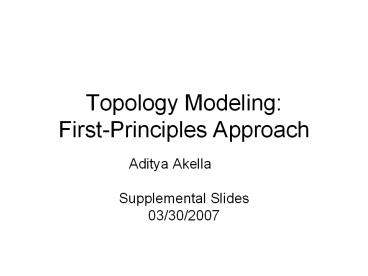Topology Modeling: First-Principles Approach - PowerPoint PPT Presentation
Title:
Topology Modeling: First-Principles Approach
Description:
Consider the explicit design of the Internet. Annotated network graphs (capacity, bandwidth) ... Define the metric (di = degree of node i) ... – PowerPoint PPT presentation
Number of Views:33
Avg rating:3.0/5.0
Title: Topology Modeling: First-Principles Approach
1
Topology Modeling First-Principles Approach
- Aditya Akella
- Supplemental Slides
- 03/30/2007
2
Challenges
Why Topology Modeling
- Evaluate performance of protocols
- Protect Internet
- Resource provisioning
- Understand large scale networks
- Large Size
- Real topologies are not publicly available
- Incredible variability in many aspects
3
Trends in Topology Modeling
- Observation
- Modeling Approach
4
Power Laws and Internet Topology
Source Faloutsos et al. (1999)
Rank R(d)
R(d) P (Dgtd) x nodes
Degree d
- Router-level graph Autonomous System (AS) graph
- Led to active research in degree-based network
models
5
Degree-Based Models of Topology
- Preferential Attachment
- Growth by sequentially adding new nodes
- New nodes connect preferentially to nodes having
more connections - Examples Inet, GPL, AB, BA, BRITE, CMU power-law
generator
- Expected Degree Sequence
- Based on random graph models that skew
probability distribution to produce power laws in
expectation - Examples Power Law Random Graph (PLRG),
Generalized Random Graph (GRG)
6
Features of Degree-Based Models
Preferential Attachment
Expected Degree Sequence
- Degree sequence follows a power law (by
construction) - High-degree nodes correspond to highly connected
central hubs, which are crucial to the system - Achilles heel robust to random failure, fragile
to specific attack
7
Li et al.
- Consider the explicit design of the Internet
- Annotated network graphs (capacity, bandwidth)
- Technological and economic limitations
- Network performance
- Seek a theory for Internet topology that is
explanatory and not merely descriptive. - Explain high variability in network connectivity
- Ability to match large scale statistics (e.g.
power laws) is only secondary evidence
8
Router Technology Constraint
Cisco 12416 GSR, circa 2002
Total Bandwidth
Bandwidth per Degree
9
Aggregate Router Feasibility
10
Variability in End-User Bandwidths
1e4
Ethernet 1-10Gbps
1e3
1e2
Ethernet 10-100Mbps
Connection Speed (Mbps)
a few users have very high speed connections
1e1
Broadband Cable/DSL 500Kbps
1
1e-1
Dial-up 56Kbps
most users have low speed connections
1e-2
1e6
1e2
1
1e4
1e8
Rank (number of users)
11
Heuristically Optimal Topology
Mesh-like core of fast, low degree routers
Cores
High degree nodes are at the edges.
Edges
12
Northern Lights
Merit
OneNet
Kansas City
Indian- apolis
Denver
Chicago
Seattle
New York
Wash D.C.
Sunnyvale
Los Angeles
Atlanta
Houston
PSC
Abilene Backbone Physical Connectivity (as of
December 16, 2003)
13
Metrics for Comparison Network Performance
- Given realistic technology constraints on
routers, how well is the network able to carry
traffic?
14
Structure Determines Performance
PA
PLRG/GRG
HOT
P(g) 1.19 x 1010
P(g) 1.64 x 1010
P(g) 1.13 x 1012
15
Likelihood-Related Metric
Define the metric
(di degree of node i)
- Easily computed for any graph
- Depends on the structure of the graph, not the
generation mechanism - Measures how hub-like the network core is
For graphs resulting from probabilistic
construction (e.g. PLRG/GRG), LogLikelihood
(LLH) ? L(g) Interpretation How likely is a
particular graph (having given node degree
distribution) to be constructed?
16
PA
PLRG/GRG
Abilene-inspired
Sub-optimal
HOT
P(g) Perfomance (bps)
Lmax l(g) 1 P(g) 1.08 x 1010































